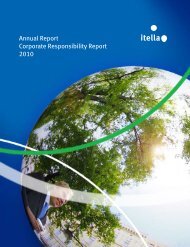Invoicing in 16 European countries - Itella Corporation
Invoicing in 16 European countries - Itella Corporation
Invoicing in 16 European countries - Itella Corporation
Create successful ePaper yourself
Turn your PDF publications into a flip-book with our unique Google optimized e-Paper software.
Figure 4. Invoices received by enterprises accord<strong>in</strong>g to delivery and process<strong>in</strong>g channels, % of <strong>in</strong>voices (n = 4765).<br />
the United K<strong>in</strong>gdom.<br />
The shares of electronic purchase <strong>in</strong>voices <strong>in</strong> Europe are quite<br />
similar to those of sales <strong>in</strong>voices. About 52% of enterprises receive<br />
electronic purchase <strong>in</strong>voices, and their share of <strong>in</strong>voices is less<br />
than 30% <strong>in</strong> Europe. Email <strong>in</strong>voices also dom<strong>in</strong>ate the reception<br />
of electronic <strong>in</strong>voices, and aga<strong>in</strong> there are quite large differences<br />
between <strong>countries</strong>. Email has a significant share <strong>in</strong> Austria, Estonia,<br />
Germany and the United K<strong>in</strong>gdom. On the other hand, the focus is on<br />
fully electronic <strong>in</strong>voice reception <strong>in</strong> F<strong>in</strong>land and Denmark (figure 4).<br />
The scann<strong>in</strong>g of received paper <strong>in</strong>voices for electronic process<strong>in</strong>g<br />
is particularly emphasized <strong>in</strong> the Nordic <strong>countries</strong>. Elsewhere <strong>in</strong><br />
Europe most scann<strong>in</strong>g is ma<strong>in</strong>ly done just for archiv<strong>in</strong>g. Scann<strong>in</strong>g<br />
is used more by enterprises that have large volumes of <strong>in</strong>voices,<br />
and companies receiv<strong>in</strong>g most <strong>in</strong>voices directly <strong>in</strong> their electronic<br />
<strong>in</strong>voic<strong>in</strong>g system also do the most scann<strong>in</strong>g for process<strong>in</strong>g. Email<br />
receivers scan primarily for archiv<strong>in</strong>g purposes, and those receiv<strong>in</strong>g<br />
ma<strong>in</strong>ly paper <strong>in</strong>voices scan the least, and mostly for archiv<strong>in</strong>g, too.<br />
Enterprises can also be segmented accord<strong>in</strong>g to their ma<strong>in</strong> ways<br />
of receiv<strong>in</strong>g purchase <strong>in</strong>voices. In this case, the best cluster solution<br />
divided companies <strong>in</strong>to three segments. The first and biggest segment<br />
receives almost all their <strong>in</strong>voices on paper. Because <strong>in</strong>voice volumes<br />
to these companies are below average, their share of <strong>in</strong>voices is only<br />
61%, though their share of enterprises is 71%. Paper reception is<br />
emphasized <strong>in</strong> the manufactur<strong>in</strong>g branch and smallish enterprises<br />
with 10–49 employees and a turnover of €400,000–2,000,000.<br />
The paper reception segment has a share of clearly over 60% <strong>in</strong> all<br />
<strong>countries</strong> other than Estonia and the United K<strong>in</strong>gdom. It has a share<br />
of over 90%<strong>in</strong> Lithuania, Poland, Slovakia and Sweden.<br />
The rema<strong>in</strong><strong>in</strong>g two segments receive ma<strong>in</strong>ly electronic <strong>in</strong>voices,<br />
and it should be noted that the more <strong>in</strong>voices an enterprise receives,<br />
the more advanced will be the electronification of their reception.<br />
Enterprises us<strong>in</strong>g ma<strong>in</strong>ly full electronic reception get almost twice<br />
as many <strong>in</strong>voices as those receiv<strong>in</strong>g almost all <strong>in</strong>voices on paper.<br />
5 | <strong>Itella</strong> Information survey: <strong>Invoic<strong>in</strong>g</strong> <strong>in</strong> <strong>16</strong> <strong>European</strong> <strong>countries</strong><br />
Even those enterprises receiv<strong>in</strong>g their <strong>in</strong>voices ma<strong>in</strong>ly via email have<br />
<strong>in</strong>voice volumes clearly above average. In total, 29% of companies<br />
receive ma<strong>in</strong>ly electronic <strong>in</strong>voices, but the proportion of <strong>in</strong>voices<br />
these companies receive is no less than 39% of the total volume of<br />
all <strong>in</strong>voices received by companies. The fully electronic reception<br />
segment is emphasized <strong>in</strong> the public sector, and accord<strong>in</strong>g to country<br />
it is biggest <strong>in</strong> F<strong>in</strong>land, Denmark and the United K<strong>in</strong>gdom. The email<br />
segment is stressed <strong>in</strong> the construction and trade branches, and it<br />
is clearly greatest <strong>in</strong> Estonia.<br />
The larger enterprises are more advanced <strong>in</strong> electronification.<br />
Furthermore, <strong>in</strong> these companies there is confidence that<br />
electronification will cont<strong>in</strong>ue to advance faster. Trust <strong>in</strong><br />
electronification also becomes stronger the more a company’s own<br />
<strong>in</strong>voic<strong>in</strong>g is electronified. Enterprises that send and receive ma<strong>in</strong>ly<br />
fully electronic <strong>in</strong>voices are confident of a more electronic future, next<br />
come high-level senders and receivers of email <strong>in</strong>voices, whereas<br />
those who send and receive ma<strong>in</strong>ly paper <strong>in</strong>voices make up the tail<br />
end.<br />
The most optimistic expectations of the progression of<br />
electronification are to be found <strong>in</strong> the Nordic and Baltic <strong>countries</strong>.<br />
Slower electronification is forecast for Germany and Eastern Europe.<br />
Comparison with the earlier <strong>in</strong>voic<strong>in</strong>g study of five <strong>countries</strong> illustrates<br />
that the share of fully electronic <strong>in</strong>voices has clearly <strong>in</strong>creased s<strong>in</strong>ce<br />
2008 <strong>in</strong> the Nordic <strong>countries</strong>, but not so much <strong>in</strong> Germany. The change<br />
<strong>in</strong> the use of email <strong>in</strong>voices is not known because the share of email<br />
<strong>in</strong>voices was not measured <strong>in</strong> the previous study. Further, trust <strong>in</strong><br />
the future <strong>in</strong>crease <strong>in</strong> electronification has grown remarkably and is<br />
most evident <strong>in</strong> the Nordic <strong>countries</strong>. In Germany similar progress<br />
could not be found.<br />
Table 1 sums up the evaluations of change. Expectations concern<strong>in</strong>g<br />
the progress of electronification are compared to the present state<br />
of electronification <strong>in</strong> each country, and <strong>16</strong> <strong>European</strong> <strong>countries</strong><br />
are ranked accord<strong>in</strong>g to that difference <strong>in</strong> both sales and purchase



